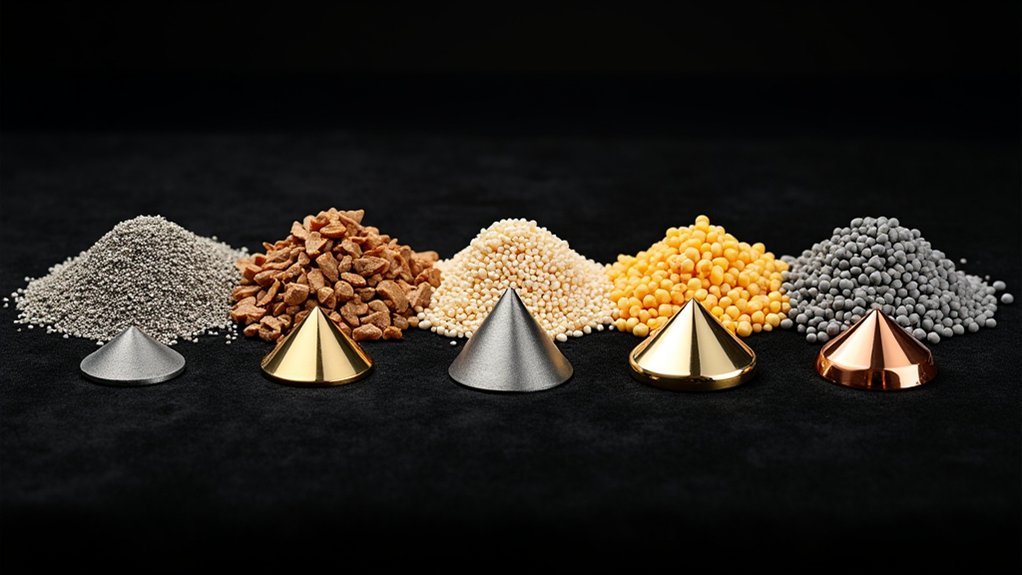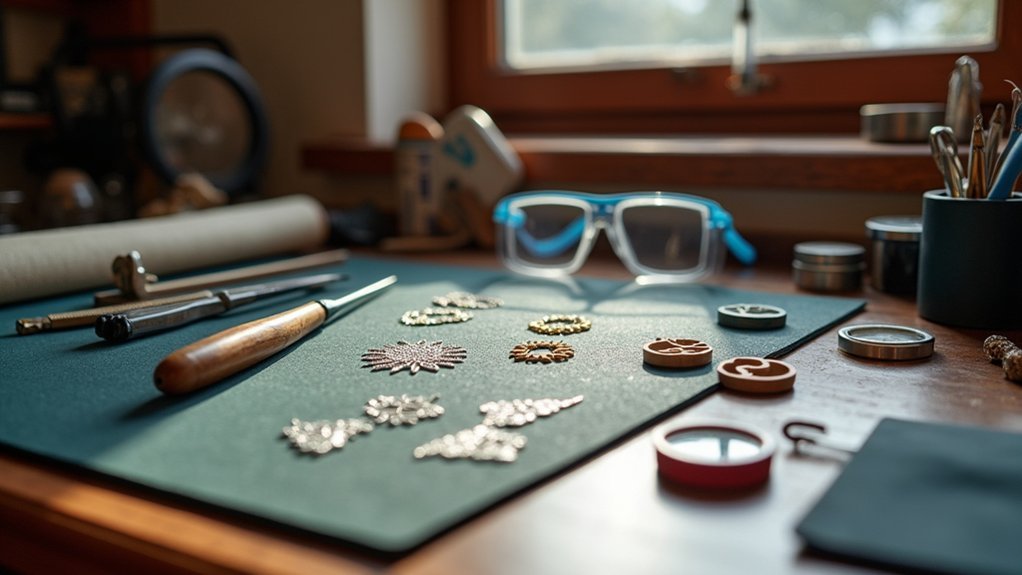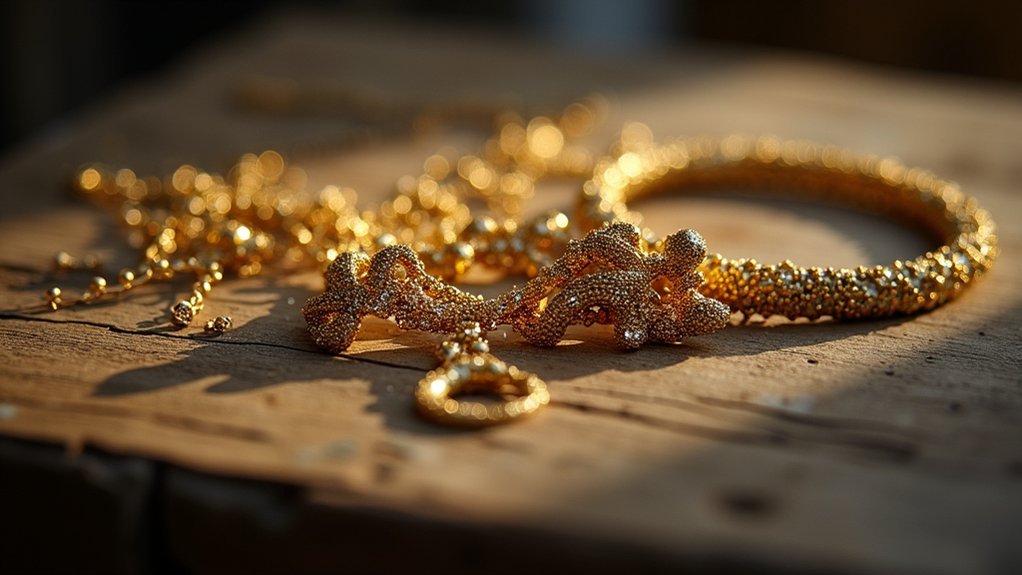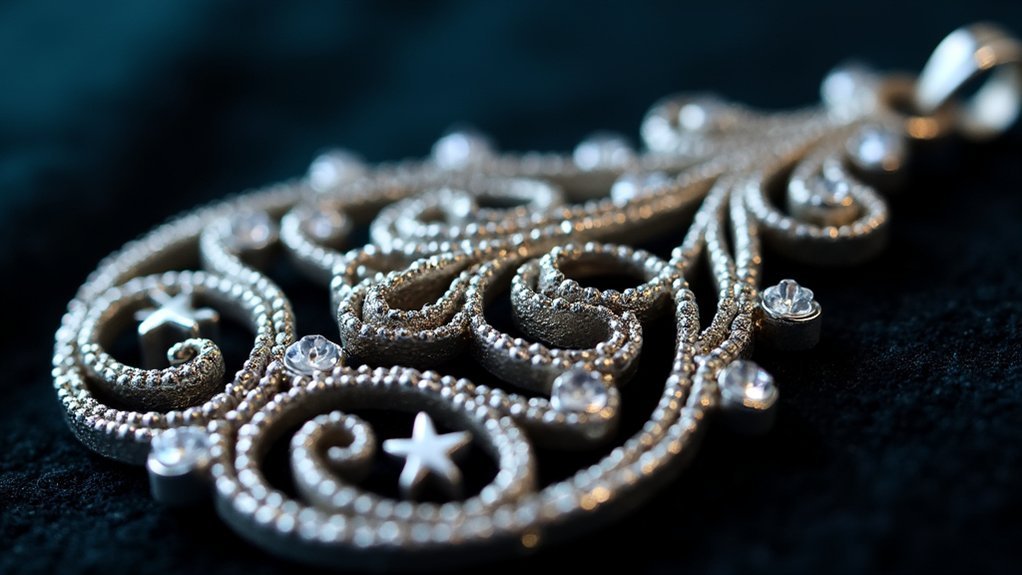You’ve invested in a quality tumbler, but are you using the right polishing media for your metals? The perfect shine doesn’t happen by chance. Different metals—from delicate silver to stubborn stainless steel—demand specific media types to achieve professional results. What works brilliantly for brass might damage aluminum beyond repair. In 2025, new formulations and innovative materials are changing the polishing game entirely, and knowing which to choose can save you countless hours of frustration.
500W Magnetic Tumbler for Jewelry Polishing
The 500W Magnetic Tumbler stands out as the essential time-saver for jewelry repair professionals who need efficient clean-up after soldering, sizing, or setting. This powerful 2000RPM polisher delivers pre-final polish in minutes through its multi-angle polishing capability.
You’ll appreciate its versatility with the 10-60 minute time control featuring 6 timer levels. The tumbler effectively removes scratches and smooths surfaces without compromising fine details like engravings or logos. For maximum durability, rinse the upgraded heavy-duty plastic bowl after each cycle and spray with cold water every 30-35 minutes. Remember not to exceed 60-minute cycles to prevent overheating.
Best For: Jewelry repair professionals and small metal workshop owners who need efficient polishing, deburring, and cleaning of jewelry pieces and intricate metal parts.
Pros:
- Powerful 2000RPM motor with 500W capacity efficiently polishes jewelry and removes scratches in minutes
- Versatile timing control with 6 levels ranging from 10-60 minutes allows customization for different polishing needs
- Multi-angle polishing capability reaches difficult areas like hollows, corners, and cracks without compromising fine details
Cons:
- Cannot run continuously for more than 60 minutes due to potential overheating issues
- Requires regular maintenance including rinsing after each cycle and cooling with water every 30-35 minutes
- Limited to smaller items and may not be suitable for larger jewelry pieces or bulky metal components
8 LBS Rock Tumbler Grit Kit with Ceramic Tumbling Filler Media
Serious rock hounds who need an extensive solution will appreciate the 8 LBS Rock Tumbler Grit Kit with Ceramic Tumbling Filler Media. This universal kit includes 6 pounds of silicon carbide and aluminum oxide grits across four grades, plus 2 pounds of ceramic filler media.
You’ll find everything packaged in secure plastic jars with clear labels and a measuring scoop to prevent mess. The aluminum oxide final polish delivers a professional wet-look shine, while the ceramic media cushions your stones for even polishing. It processes up to 20 pounds of rocks, making it ideal for hobbyists seeking professional results.
Best For: Rock tumbling enthusiasts who need a comprehensive grit kit that can process larger batches of stones with professional-quality results.
Pros:
- Complete kit with four grit grades (60, 220, 500, 1200) and ceramic filler media in convenient plastic jars
- Includes measuring scoop and clear instructions suitable for both beginners and experienced hobbyists
- Final aluminum oxide polish delivers a professional wet-look shine that enhances stone appearance
Cons:
- May be excessive for casual hobbyists who only tumble occasionally or work with small batches
- Works best with harder rocks (Mohs 7+), possibly delivering less impressive results with softer specimens
- Requires thorough cleaning between grit stages to prevent contamination and achieve optimal results
Frankford Arsenal Quick-N-EZ Vibratory Case Tumbler for Reloading
Designed for ammunition reloaders seeking efficiency without breaking the bank, the Frankford Arsenal Quick-N-EZ Vibratory Case Tumbler stands out with its impressive capacity to process up to 600 9mm or 350 .223 cases simultaneously.
The unique bowl design enhances brass agitation for faster cleaning while extending brass life and reducing wear on your dies. You’ll appreciate the transparent lid for monitoring progress and the convenient cord-mount ON/OFF switch. It’s optimized for use with Frankford Arsenal’s walnut or corn cob media to effectively remove lube and oxidation.
Users report quieter operation than previous models and consistently shiny results, though some recommend replacing the stock wing nut for improved durability.
Best For: Beginner to intermediate reloaders looking for an affordable, efficient way to clean large batches of brass casings without manual scrubbing.
Pros:
- High capacity drum handles up to 600 9mm cases in a single batch, saving time for high-volume reloaders
- Specialized bowl design creates aggressive cleaning action that produces noticeably shinier brass while extending case life
- Transparent lid allows for monitoring progress without interrupting the cleaning cycle
Cons:
- Short power cable may require extension cords for some workspace setups
- Stock wing nut feels cheap and may need replacement for improved durability
- Some users report potential overheating issues, particularly when used in regions with incompatible voltage
Single Barrel Tumbler, Jewelry and Metal Polishing Kit
Jewelry enthusiasts seeking professional-grade results will find WireJewelry’s Single Barrel Tumbler Kit an impressive all-in-one solution. The heavy-duty motor supports 24/7 operation, while the leak-proof rubber barrel minimizes noise during polishing sessions.
You’ll appreciate the included 1-pound Jewelers Mix Shot, featuring three specialized shapes (diagonal, round, and pin) that work together to create mirror finishes on various metals. The 8-ounce Shinebrite compound (making 4 gallons) efficiently cleans and brightens your pieces.
With a 4.3-star rating, users consistently report dramatic improvements in their jewelry’s appearance, particularly for sterling silver items.
Best For: Jewelry makers, metalworkers, and hobbyists seeking professional-quality polishing results at home without investing in expensive commercial equipment.
Pros:
- Complete kit includes everything needed to start polishing immediately: tumbler, stainless steel shot mix, and burnishing compound
- Heavy-duty motor designed for continuous operation with a generous 2-year warranty and lifetime belt replacement
- Three-shape shot combination (diagonal, round, pin) effectively reaches all areas of jewelry pieces for a comprehensive mirror finish
Cons:
- New rubber barrel has a strong odor that some users find unpleasant
- Small shot pieces can be difficult to manage and may occasionally get stuck in jewelry settings
- At 10 pounds, the unit is relatively heavy and takes up significant counter space compared to smaller polishers
Rock Tumbler Polishing Grits and Ceramic Tumbling Media Kit for Any Rock Tumblers
KomeStones’ Rock Tumbler Polishing Grits and Ceramic Tumbling Media Kit delivers professional-quality results for both novice and veteran rock enthusiasts.
This versatile kit includes four silicon carbide and aluminum oxide grits plus 1 lb of ceramic pellets—enough to polish up to 25 lbs of rocks. You’ll find it compatible with all KomeStones tumblers (K1, K1 Pro, K2, and K4) and any other brand.
Measurement is effortless with included spoons; just add two spoons per pound of rocks. The non-abrasive ceramic pellets can be reused throughout all polishing stages, making this kit both economical and effective.
Best For: Rock hobbyists of all ages and experience levels who need a versatile, effective polishing kit compatible with any rock tumbler model.
Pros:
- Complete kit with four polishing grits and ceramic pellets capable of processing up to 25 pounds of rocks
- Includes convenient measuring spoons and individual packaging for each grit for easy use and storage
- Reusable ceramic filler pellets add value and improve tumbling efficiency across all polishing stages
Cons:
- Additional grits may be needed for processing larger quantities of rocks (more than 25 pounds)
- No specific instructions included for different rock types which may require varying techniques
- Beginners might need additional guidance beyond the basic measurement recommendations (two spoons per pound)
Factors to Consider When Choosing Tumbler Polishing Media: Which Types Work for Different Metals?
Selecting the right tumbler polishing media for your metals requires careful consideration of material compatibility to prevent damage and achieve ideal results. You’ll need to match media size to your project’s intricacy, while keeping your desired finish in mind—whether you’re aiming for a mirror shine or satin appearance. Proper contamination prevention and maintaining the correct media-to-metal load ratio will guarantee consistent quality across your polished items.
Material Compatibility Analysis
When pairing metals with tumbler polishing media, compatibility becomes the critical factor that determines your final results.
For harder metals like stainless steel and silver, you’ll want to reach for steel shot media. It burnishes these surfaces to a brilliant shine while preserving intricate details. If you’re working with softer materials or pieces containing stones, ceramic media offers the cushioning needed to prevent damage while still delivering an even finish.
Silicon carbide grits excel at the initial grinding stages, particularly for harder metals with imperfections that need aggressive removal. For the best results with jewelry pieces, consider a multi-stage approach: start with silicon carbide for rough smoothing, then progress to stainless steel shot for that mirror-like finish you’re after. Your metal’s hardness should always guide your media selection.
Media Size Matters
Three critical dimensions govern your tumbler media selection: hardness, material type, and critically, size. When polishing intricate metalwork, size becomes your primary consideration for reaching those challenging corners and crevices.
For delicate pieces with fine engravings or precise details, opt for smaller media like tiny steel shots or pins. They’ll preserve your workpiece’s integrity while delivering a meticulous polish. Conversely, larger media excels at deburring and smoothing rough surfaces on bulkier components, removing material more efficiently.
Match your media size to your metal type as well—softer metals benefit from smaller media to prevent unwanted scratching, while harder metals might require a strategic mix of sizes. Remember that finer media typically extends polishing time but rewards you with superior shine, while coarser options accelerate the initial smoothing process.
Intended Finish Results
How you envision your final piece ultimately dictates your media selection. For a mirror-like, highly reflective surface—perfect for jewelry or decorative items—you’ll need to progress through multiple grit sizes, finishing with ultra-fine media that provides that wet-polished look ceramic media delivers so effectively on sterling silver.
If you’re working with softer metals, select gentler media that won’t distort delicate details while still achieving the desired shine. Harder metals can withstand more aggressive media, which often speeds up the polishing process considerably.
For professional results, consider a staged approach: begin with coarser media to shape and remove major imperfections, then shift to progressively finer grits for that flawless finish. This methodical progression guarantees you’ll achieve precisely the aesthetic you’re aiming for without compromising your piece’s integrity.
Contamination Prevention Concerns
Cross-contamination between different metals during tumbling can sabotage even the most carefully planned finishing process. You’ll need to establish strict protocols for cleaning media between uses to prevent residue transfer that can compromise your finish quality.
Consider investing in dedicated media sets for different metal types. This approach eliminates cross-contamination risk entirely and preserves the distinct finish characteristics of each metal you work with.
When selecting media materials, ceramics and stainless steel offer superior contamination resistance compared to softer alternatives. They’re less likely to absorb residues or introduce unwanted particles during polishing.
Don’t overlook regular inspection and replacement of your media. Even high-quality materials degrade over time, potentially introducing contaminants that could scratch or dull your pieces. Additionally, maintain a clean tumbler environment to guarantee ideal results.
Load Ratio Considerations
Achieving the perfect finish with tumbler polishing doesn’t just depend on media type—the load ratio serves as a critical yet often overlooked factor in the process. This ratio, defined as the weight of polishing media to the weight of your items, can make or break your results.
For softer metals like aluminum, you’ll want to use a lower 1:1 ratio to prevent excessive wear while achieving that desirable smooth finish. Harder metals such as stainless steel benefit from higher ratios (2:1 or 3:1), which provide more aggressive polishing action and faster imperfection removal.
Don’t forget to adjust your ratios based on your items’ shapes and sizes. Irregularly shaped pieces may require different proportions for even polishing. Maintaining proper load ratios not only improves your results but also extends your media’s lifespan.
Cycle Time Effects
While selecting the right media type is crucial, your tumbling cycle duration ultimately determines the quality of your finished pieces. You’ll need to balance timing carefully—typically between 10 to 60 minutes—to achieve ideal results without damaging your items.
For jewelry repair work, even brief 5-minute tumbles can dramatically enhance post-soldering finishes. Complex pieces with intricate designs require longer cycles to guarantee polish reaches all surfaces, including corners and hollow sections. However, extended tumbling can compromise delicate features like engravings or logos, particularly in softer metals.
Monitor your process regularly when working with precision items. Shorter cycles often fail to properly clean and polish complex surfaces, while excessive tumbling risks overheating and material damage. Adjust your timing based on your specific metal type and desired finish quality.
Frequently Asked Questions
How Long Does Tumbler Polishing Typically Take for Different Metals?
You’ll find tumbler polishing times vary considerably: softer metals like copper need 2-4 hours, silver takes 4-6 hours, while harder metals like stainless steel require 8-12 hours for best results.
Can Polishing Media Be Reused, and How Many Times?
Yes, most polishing media can be reused. You’ll get 5-10 uses from organic media, 15-20 from ceramics, and 30+ from steel media. Just rinse them thoroughly between uses to maintain effectiveness.
What Safety Precautions Should I Take When Handling Polishing Media?
When handling polishing media, you’ll need to wear gloves, eye protection, and a dust mask. Don’t inhale the dust, wash hands after use, and keep the area well-ventilated to avoid respiratory issues.
How Do I Dispose of Used Tumbling Media Properly?
You should dispose of used tumbling media by checking local regulations first. For most media, rinse thoroughly and discard with regular trash. For chemically-treated media, contact your local hazardous waste facility for proper disposal guidelines.
Can I Mix Different Types of Media for Better Results?
Yes, you can mix different media types for enhanced results. Try combining ceramic pins with walnut shells or steel shot with corn cob for a balanced approach to cutting and polishing your pieces simultaneously.





Leave a Reply